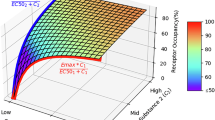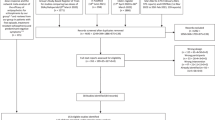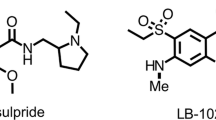Abstract
Conditioned avoidance response (CAR) behavior and catalepsy (CAT) are the standard preclinical tests used to predict antipsychotic activity and motor side-effect liability, respectively. Recent data in patients show that striatal dopamine D2 occupancy predicts antipsychotic response (at 65% D2 occupancy) and motor side-effects (at greater than 80%). To relate preclinical and clinical findings, this study examined the relationship between striatal D2 occupancy, CAT and CAR in rats receiving typical and atypical antipsychotics. CAT was observed in animals receiving haloperidol, risperidone and olanzapine, but only at doses that produced a D2 receptor occupancy ⩾85%. The D2 occupancy of quetiapine did not cross the 85% threshold (up to 100 mg/kg) and it did not show catalepsy. All drugs were effective in the CAR model at a lower level of D2 occupancy than was required for catalepsy. We suggest that the CAR and CAT models may have displayed high predictive accuracy because they share with the clinical condition a common underlying mechanism: dopamine D2 occupancy. The implications of this finding for understanding antipsychotic action as well as the continued use of these models in drug discovery is discussed.
Similar content being viewed by others
Log in or create a free account to read this content
Gain free access to this article, as well as selected content from this journal and more on nature.com
or
References
Ahlenius S, Hillegaart V . (1986): Involvement of extrapyramidal motor mechanisms in the suppression of locomotor activity by antipsychotic drugs: a comparison between the effects produced by pre- and post-synaptic inhibition of dopaminergic neurotransmission. Pharmacol Biochem Behav 24: 1409–1415
Announcement (1999): Management Decisions on Priority Pipeline Products—MDL 100907, Vision Extra, Vol 4, pp 2–3
Arnt J, Skarsfeldt T, Hyttel J . (1997): Differentiation of classical and novel antipsychotics using animal models. Int Clin Psychopharmacol 12 Suppl 1: S9–S17
Bodick NC, Offen WW, Levey AI, Cutler NR, Gauthier SG, Satlin A, Shannon HE, Tollefson GD, Rasmussen K, Bymaster FP, Hurley DJ, Potter WZ, Paul SM . (1997): Effects of xanomeline, a selective muscarinic receptor agonist, on cognitive function and behavioral symptoms in Alzheimer disease. Arch Neurol 54: 465–473
Bristow LJ, Collinson N, Cook GP, Curtis N, Freedman SB, Kulagowski JJ, Leeson PD, Patel S, Ragan CI, Ridgill M, Saywell KL, Tricklebank MD . (1997a): L-745,870, a subtype selective dopamine D4 receptor antagonist, does not exhibit a neuroleptic-like profile in rodent behavioral tests. Journal of Pharmacology and Experimental Therapeutics 283: 1256–1263
Bristow LJ, Kramer MS, Kulagowski J, Patel S, Ragan CI, Seabrook GR . (1997b): Schizophrenia and L-745, 870, a novel dopamine D4 receptor antagonist. Trends in Pharmacological Sciences 18: 186–188
Calderon SF, Sanberg PR, Norman AB . (1988): Quinolinic acid lesions of rat striatum abolish D1- and D2-dopamine receptor-mediated catalepsy. Brain Res 450: 403–407
Farde L, Nordstrom AL, Wiesel FA, Pauli S, Halldin C, Sedvall G . (1992): Positron emission tomographic analysis of central D1 and D2 dopamine receptor occupancy in patients treated with classical neuroleptics and clozapine: relation to extrapyramidal side effects. Archives of General Psychiatry 49: 538–544
Farde L, Wiesel FA, Halldin C, Sedvall G . (1988): Central D2-dopamine receptor occupancy in schizophrenic patients treated with antipsychotic drugs. Archives of General Psychiatry 45: 71–76
Gefvert O, Bergstrom M, Langstrom B, Lundberg T, Lindstrom L, Yates R . (1998): Time course of central nervous dopamine-D-2 and 5-HT2 receptor blockade and plasma drug concentrations after discontinuation of quetiapine (Seroquel(R)) in patients with schizophrenia. Psychopharmacology 135: 119–126
Hauber W, Munkle M . (1997): Motor depressant effects mediated by dopamine D2 and adenosine A2A receptors in the nucleus accumbens and the caudate-putamen. Eur J Pharmacol 323: 127–131
Higgins GA . (1998): From rodents to recovery: Development of animal models of schizophrenia. CNS Drugs 9: 59–68
Janssen PA . (1967): The pharmacology of haloperidol. Int J Neuropsychiatry 3 (Suppl 1): 10–18
Janssen PA, Niemegeers CJ, Awouters F, Schellekens KH, Megens AA, Meert TF . (1988): Pharmacology of risperidone (R 64 766), a new antipsychotic with serotonin-S2 and dopamine-D2 antagonistic properties. The Journal of Pharmacology and Experimental Therapeutics 244: 685–693
Janssen PA, Niemegeers CJ, Schellekens KH, Lenaerts FM . (1967): Is it possible to predict the clinical effects of neuroleptic drugs (major tranquilizers) from animal data? IV. An improved experimental design for measuring the inhibitory effects of neuroleptic drugs on amphetamine- or apomorphine-induced “Cheroing” and “agitation” in rats. Arzneimittelforschung 17: 841–854
Kapur S, Seeman P . (2001): Does fast dissociation from the dopamine D2 receptors explain atypical antipsychotic action—a new hypothesis. American Journal of Psychiatry 158: 360–369
Kapur S, Zipursky R, Jones C, Remington G, Houle S . (2000a): Relationship between dopamine D(2) occupancy, clinical response, and side effects: A double-blind PET study of first-episode schizophrenia. Am J Psychiatry 157: 514–520
Kapur S, Zipursky R, Jones C, Shammi CS, Remington G, Seeman P . (2000b): A positron emission tomography study of quetiapine in schizophrenia: a preliminary finding of an antipsychotic effect with only transiently high dopamine D2 receptor occupancy. Arch Gen Psychiatry 57: 553–559
Kapur S, Zipursky RB, Remington G . (1999): Clinical and theoretical implications of 5-HT2 and D2 receptor occupancy of clozapine, risperidone, and olanzapine in schizophrenia. Am J Psychiatry 156: 286–293
Kramer MS, Last B, Getson A, Reines SA . (1997): The effects of a selective D4 dopamine receptor antagonist (L-745,870) in acutely psychotic inpatients with schizophrenia. D4 Dopamine Antagonist Group [published erratum appears in Arch Gen Psychiatry 54:1080]. Arch Gen Psychiatry 54: 567–572
Migler BM, Warawa EJ, Malick JB . (1993): Seroquel: behavioral effects in conventional and novel tests for atypical antipsychotic drug. Psychopharmacology 112: 299–307
Moore NA, Tye NC, Axton MS, Risius FC . (1992): The behavioral pharmacology of olanzapine, a novel “atypical” antipsychotic agent. The Journal of Pharmacology and Experimental Therapeutics 262: 545–551
Nordstrom AL, Farde L, Nyberg S, Karlsson P, Halldin C, Sedvall G . (1995): D1, D2, and 5-HT2 receptor occupancy in relation to clozapine serum concentration: a PET study of schizophrenic patients [see comments]. Am J Psychiatry 152: 1444–1449
Nordstrom AL, Farde L, Wiesel FA, et al. (1993): Central D2-dopamine receptor occupancy in relation to antipsychotic drug effects—a double-blind PET study of schizophrenic patients. Biological Psychiatry 33: 227–235
Salamone JD, Cousins MS, Snyder BJ . (1997): Behavioral functions of nucleus accumbens dopamine: empirical and conceptual problems with the anhedonia hypothesis. Neurosci Biobehav Rev 21: 341–359
Setler P, Sarau H, McKenzie G . (1976): Differential attenuation of some effects of haloperidol in rats given scopolamine. Eur J Pharmacol 39: 117–126
Shannon HE, Hart JC, Bymaster FP, Calligaro DO, DeLapp NW, Mitch CH, Ward JS, Fink-Jensen A, Sauerberg P, Jeppesen L, Sheardown MJ, Swedberg MD . (1999): Muscarinic receptor agonists, like dopamine receptor antagonist antipsychotics, inhibit conditioned avoidance response in rats. J Pharmacol Exp Ther 290: 901–907
Shannon HE, Rasmussen K, Bymaster FP, Hart JC, Peters SC, Swedberg MD, Jeppesen L, Sheardown MJ, Sauerberg P, Fink-Jensen A . (2000): Xanomeline, an M(1)/M(4) preferring muscarinic cholinergic receptor agonist, produces antipsychotic-like activity in rats and mice. Schizophr Res 42: 249–259
Siegel B, Castellan NR, Jr . (1988): Nonparametric Statistics for The Behavioral Sciences. New York, McGraw-Hill
Truffinet P, Tamminga CA, Fabre LF, Meltzer HY, Riviere ME, Papillon-Downey C . (1999): Placebo-controlled study of the D4/5-HT2A antagonist fananserin in the treatment of schizophrenia. Am J Psychiatry 156: 419–425
Wadenberg M-LG . (1996): Serotonergic mechanisms in neuroleptic-induced catalepsy in the rat. Neurosci Biobehav Rev 20: 325–339
Wadenberg M-LG, Ahlenius S . (1991): Antipsychotic-like profile of combined treatment with raclopride and 8-OH-DPAT in the rat: enhancement of antipsychotic-like effects without catalepsy. J Neural Transm Gen Sect 83: 43–53
Wadenberg M-LG, Ericson E, Magnusson O, Ahlenius S . (1990): Suppression of conditioned avoidance behavior by the local application of (-)sulpiride into the ventral, but not the dorsal, striatum of the rat. Biol Psychiatry 28: 297–307
Wadenberg M-LG, Hicks PB . (1999): The conditioned avoidance response test re-evaluated: is it a sensitive test for the detection of potentially atypical antipsychotics? Neurosci Biobehav Rev 23: 851–862
Wadenberg M-LG, Hicks PB, Young KA, Richter JT . (1997a): Further evidence for a role of the 5-HT2 receptor in the mediation of antipsychotic activity. Schizophrenia Research 24: 83
Wadenberg M-LG, Kapur S, Soliman A, Jones C, Vaccarino F . (2000): Dopamine D2 receptor occupancy predicts catalepsy and the suppression of conditioned avoidance response behavior in rats. Psychopharmacology (Berl)) 150: 422–429
Wadenberg M-LG, Young KA, Trompler RA, Zavodny RA, Richter TJ, Hicks PB . (1997b): A novel computer-controlled conditioned avoidance apparatus for rats. J Pharmacol Toxicol Methods 38: 211–215
Wadenberg M-LG, Hicks PB, Richter JT, Young KA . (1998): Enhancement of antipsychoticlike properties of raclopride in rats using the selective serotonin(2A) receptor antagonist MDL 100,907. Biological Psychiatry 44: 508–515
Acknowledgements
We thank Corey Jones, Alex Kecojevic, Doug Hussey, Kevin Cheung, and Judy Sinyard for their expert technical assistance. This study was partially funded by support from the Theodore and Vada Stanley Foundation (USA) and by the Canada Research Chair to SK. Partial financial support from Eli Lilly Canada and AstraZeneca Canada is acknowledged.
Author information
Authors and Affiliations
Corresponding author
Rights and permissions
About this article
Cite this article
Wadenberg, ML., Soliman, A., VanderSpek, S. et al. Dopamine D2 Receptor Occupancy Is a Common Mechanism Underlying Animal Models of Antipsychotics and Their Clinical Effects. Neuropsychopharmacol 25, 633–641 (2001). https://doi.org/10.1016/S0893-133X(01)00261-5
Received:
Revised:
Accepted:
Published:
Issue date:
DOI: https://doi.org/10.1016/S0893-133X(01)00261-5
Keywords
This article is cited by
-
Neonatal phencyclidine as a model of sex-biased schizophrenia symptomatology in adolescent mice
Psychopharmacology (2023)
-
Effect of 5-HT2A receptor antagonism on levels of D2/3 receptor occupancy and adverse behavioral side-effects induced by haloperidol: a SPECT imaging study in the rat
Translational Psychiatry (2021)
-
Dopamine D2 receptors in the expression and extinction of contextual and cued conditioned fear in rats
Experimental Brain Research (2021)
-
Structure-inspired design of β-arrestin-biased ligands for aminergic GPCRs
Nature Chemical Biology (2018)
-
In Vitro and In Vivo Characterization of PCC0104005, a Novel Modulator of Serotonin-Dopamine Activity, as an Atypical Antipsychotic Drug
Scientific Reports (2018)



